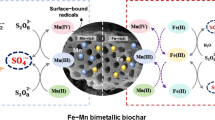Abstract
Extractions with mixtures of oxalic acid, ammonium oxalate, and ascorbic acid have been used to analyze trace metals that are occluded in Fe and Mn oxides in soil samples. In our experiments, the amount of Fe extracted from two Andisols decreased with increased extraction time using a mixture of 0.1 mol L−1 oxalic acid, 0.175 mol L−1 ammonium oxalate, and 0.19 mol L−1 ascorbic acid (OxAsc). Differential X-ray diffraction analysis showed the presence of Fe(II)C2O4 · 2H2O in the residue after the extraction, and the amount of this precipitate increased with extraction time. These results indicate that the decrease in Fe extraction with time was caused by precipitation of Fe(II)C2O4 · 2H2O. The amounts of some trace metals (Cd, Co, Mn, Ni, and Zn) extracted with OxAsc showed trends similar to that of Fe, whereas As, Cu, and Pb did not show this trend. A coprecipitation experiment showed that the concentrations of Cd, Co, Mn, Ni, and Zn markedly decreased after the precipitation of Fe(II)C2O4 · 2H2O, whereas those of As, Cu, and Pb did not noticeably change. These results indicate that some trace metals coprecipitated with Fe(II)C2O4 · 2H2O during extraction with OxAsc. This coprecipitation results in underestimation of oxide-occluded trace metals in soils; therefore, using mixtures of oxalic acid, ammonium oxalate, and ascorbic acid to extract some trace metals occluded in Fe and Mn oxides may yield erroneous data.






Similar content being viewed by others
References
Afonso, M. D. S., Morando, P., Blesa, M. A., Banwart, S., & Stumm, W. (1990). The reductive dissolution of iron oxides by ascorbate: the role of carboxylate anions in accelerating reductive dissolution. Journal of Colloid and Interface Science, 138(1), 74–82.
Benitez, L. N., & Dubois, J. P. (1999). Evaluation of ammonium oxalate for fractionating metallic trace elements in soils by sequential extraction. International Journal of Environmental Analytical Chemistry, 75(3), 261–273.
Blakemore, L. C., Searle, P. L., & Darly, B. K. (1987). Extractable iron, aluminum and silicon. In L. Blakemore (Ed.), Methods for chemical analysis of soils, New Zealand Soil Bureau scientific report 10A (pp. 71–76). Lower Hutt: DISR.
Bryant, R., Curi, N., Roth, C., & Franzmeier, D. (1983). Use of an internal standard with differential X-ray diffraction analysis for iron oxides. Soil Science Society of America Journal, 47(1), 168–173.
Cornell, R. M., & Schindler, P. (1987). Photochemical dissolution of goethite in acid/oxalate solution. Clays and Clay Minerals, 35(5), 347–352.
Davidson, C. M., Hursthouse, A. S., & Ure, A. M. (2004). Should acid ammonium oxalate replace hydroxylammonium chloride in step 2 of the revised BCR sequential extraction protocol for soil and sediment? Analytica Chimica Acta, 508(2), 193–199.
Miller, W. P., Martens, D. C., & Zelazny, L. W. (1986). Effect of sequence in extraction of trace metals from soils. Proceedings of the Soil Science Society of America, 50(3), 598–601.
Nogueira, T. A. R., Melo, W. J., Fonseca, I. M., Marcussi, S. A., Melo, G. M. P., & Marques, M. O. (2010). Fractionation of Zn, Cd and Pb in a tropical soil after 9-year sewage sludge applications. Pedosphere, 20(5), 545–556.
Pardo, F., Jordán, M. M., Sanfeliu, T., & Pina, S. (2010). Distribution of Cd, Ni, Cr, and Pb in amended soils from Alicante Province (SE, Spain). Water, Air, and Soil Pollution, 217(1–4), 535–543.
Sadamoto, H., Iimura, K., Honna, T., & Yamamoto, S. (1994). Examination of fractionation of heavy metals in soils. Japanese Journal of Soil Science and Plant Nutrition, 65(6), 645–653 (in Japanese with English summary).
Sahuquillo, A., Lopez–Sanchez, J. F., Rubio, R., Rauret, G., Thomas, R. P., Davidson, C. M., & Ure, A. M. (1999). Use of a certified reference material for extractable trace metals to assess sources of uncertainty in the BCR three-stage sequential extraction procedure. Analytica Chimica Acta, 382(3), 317–327.
Schramel, O., Michalke, B., & Kettrup, A. (2000). Study of the copper distribution in contaminated soils of hop fields by single and sequential extraction procedures. Science of the Total Environment, 263(1–3), 11–22.
Shannon, R. D. (1976). Revised effective ionic radii and systematic studies of interatomic distances in halides and chalcogenides. Acta Crystallographica, A32(5), 751–767.
Shuman, L. M. (1982). Separating soil iron-oxide and manganese-oxide fractions for micro-element analysis. Soil Science Society of America Journal, 46(5), 1099–1102.
Shuman, L. M. (1985). Fractionation method for soil microelements. Soil Science, 140(1), 11–22.
Silveira, M. L., Alleoni, L. R. F., O’Connor, G. A., & Chang, A. C. (2006). Heavy metal sequential extraction methods—a modification for tropical soils. Chemosphere, 64(11), 1929–1938.
Stumm, W. (1992). Redox Process Mediated by Surface. In Chemistry of the solid-water interface: processes at the mineral-water and particle-water interface in natural systems (pp. 309–335). New York: Wiley.
Suda, A., Makino, T., & Higashi, T. (2011). Applicability of selective dissolution of manganese oxide by acidified 0.1 M NH2OH-HCl in Japanese soils. Geoderma, 163(3–4), 291–295.
Suda, A., Makino, T., & Higashi, T. (2013). An improved selective extraction method for Mn oxides and occluded metals with emphasis on applicability to Andisols. Soil Science & Plant Nutrition, 59(6), 840–851.
Taylor, R. M., & McKenzie, R. M. (1966). The association of trace elements with manganese minerals in Australian soils. Australian Journal of Soil Research, 4(1), 29–39.
Tessier, A., Campbell, P. G. C., & Bisson, M. (1979). Sequential extraction procedure for the speciation of particulate trace metals. Analytical Chemistry, 51(7), 844–851.
Vandecasteele, C., & Block, C. B. (1997). Sample preparation. In Modern Methods for Trace Element Determination (pp. 9–53). New York: Wiley.
Acknowledgments
We thank Dr. N. Yamaguchi, Dr. Y. Maejima, Dr. K. Nakamura, Dr. I. Akahane (National Institute for Agro-Environmental Sciences), and Dr. J. Takahashi (University of Tsukuba) for their helpful comments.
Author information
Authors and Affiliations
Corresponding author
Rights and permissions
About this article
Cite this article
Suda, A., Makino, T. Methodological Drawbacks of the Extraction of Trace Metals from Fe and Mn Oxides in Soil Samples with Oxalic Acid–Ammonium Oxalate–Ascorbic Acid Solution. Water Air Soil Pollut 226, 12 (2015). https://doi.org/10.1007/s11270-014-2285-2
Received:
Accepted:
Published:
DOI: https://doi.org/10.1007/s11270-014-2285-2




